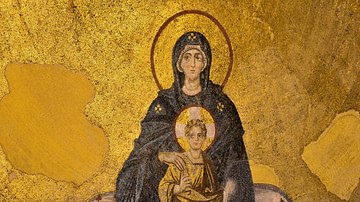Review

| Rating: | |
|---|---|
| Title: | Trafficking with Demons: Magic, Ritual, and Gender from Late Antiquity to 1000 |
| Author: | Martha Rampton |
| Audience: | University |
| Difficulty: | Medium |
| Publisher: | Cornell University Press |
| Published: | 2022 |
| Pages: | 480 |
"Trafficking with Demons" fills a much-needed gap in the scholarship of magic, covering broadly the 4th to the 10th centuries CE. Working with a breadth of literary sources, Martha Rampton explores the nature of magic and the ramifications of the restrictions set by Christian authorities during this period, particularly for women. The legacy of these changes still affects our understanding of magic today, making this book valuable to anyone interested in the early history of magic in Europe.
Martha Rampton’s two primary goals with this book were to define in specific terms what “magic” meant and to examine how that meaning changed over time. She divides the book into four parts, with the last three focusing on specific time periods rather than themes. In Part One, Rampton summarizes the historiography of the study of magic, from Augustine in the 5th century to modern authors like James Frazer, as well as her source material. She pulls from various ancient and early medieval literary sources, including law codes, medical texts, sermons, and treatises, to analyze the concept of "magic." Using this historiography, she also creates some parameters for keywords, such as “ritual” and “demon,” that feature heavily in the rest of the book. In Parts Two to Four, Rampton asks why identifying magic was so important to early Christian authorities. The author argues that the fierce competition with Roman paganism and the hostile environment of the Roman Empire caused early Christianity to struggle for legitimacy, which they attempted to create by separating Christian rituals from pagan magic.
While Rampton accomplishes her first goal of defining “magic” in Part One, it is her second goal of examining changes in magic over time that haunts this book. Parts Two to Four suffer from a lack of signposting of the changes Rampton wants to highlight, the true significance of which only becomes clear in the book's last two chapters. Rampton intended these middle chapters to show changes to how different types of magic were conceptualized and the reactions of religious authorities, but often the changes are so subtle that they are lost in the wealth of evidence she provides. The repetition of sub-headings (e.g. Poison, Divination) also blurs the individual sections together. Including images of the manuscripts she references would have enlivened the book and introduced some variety into these sections. Given that these parts form the main body of the book, it is a shame that it is so hard to follow Rampton’s argument.
The other major element of Rampton’s argument is the relationship between magic and gender. By "gender," Rampton seems to mean “women” only. While the role of women in magic in this period is not the book's focus, it increases in significance as the chapters progress. The crux of Rampton’s argument is that, by 800 CE, magic and the female power that had come to be inherent in it was seen as ineffective. A more interesting point that Rampton makes is how exactly magic came to be associated primarily with women. From the Roman rituals of religious ecstasy being seen as “womanish” to a 9th-century court case in which an empress was accused of using love magic, Rampton argues that the change hinged on how early Christianity legitimized itself in contrast to paganism. As Christian authorities worked to define and professionalize “acceptable” magic, such as prophecy and miracles, in the 5th to 7th centuries, access for women was increasingly cut off by their lack of training (and their inability to obtain that training). This meant that female magic practitioners could only access the “unacceptable” magic, while the “acceptable” was separated from the concept of magic itself, indelibly intertwining women with magic.
Martha Rampton is Professor of History at Pacific University. Overall, Rampton argues persuasively for why the Late Antique and Early Medieval periods were crucially transitional for the concept of magic. The wealth and breadth of evidence presented in this book is undeniable. At the very least, this book should be well-received as a literary sourcebook for magic in these periods. However, its true value is to be found in the argument that Rampton unspools in the background of every chapter: a point of no return was crossed when women were forever associated with (malicious) magic. It is the legacy of that shift that accounts for why in the Western world today we think of a woman when we hear the word “witch”.
About the Reviewer
Cite This Work
APA Style
Hagler, A. (2024, July 22). Trafficking with Demons: Magic, Ritual, and Gender from Late Antiquity to 1000. World History Encyclopedia. Retrieved from https://www.worldhistory.org/review/460/trafficking-with-demons-magic-ritual-and-gender-fr/
Chicago Style
Hagler, Alex. "Trafficking with Demons: Magic, Ritual, and Gender from Late Antiquity to 1000." World History Encyclopedia. Last modified July 22, 2024. https://www.worldhistory.org/review/460/trafficking-with-demons-magic-ritual-and-gender-fr/.
MLA Style
Hagler, Alex. "Trafficking with Demons: Magic, Ritual, and Gender from Late Antiquity to 1000." World History Encyclopedia. World History Encyclopedia, 22 Jul 2024, https://www.worldhistory.org/review/460/trafficking-with-demons-magic-ritual-and-gender-fr/. Web. 18 Apr 2025.




